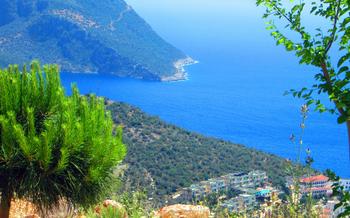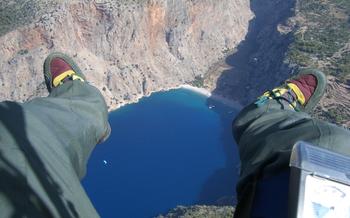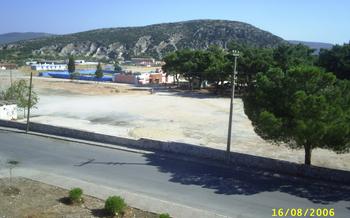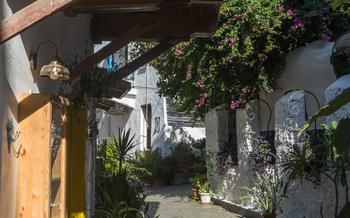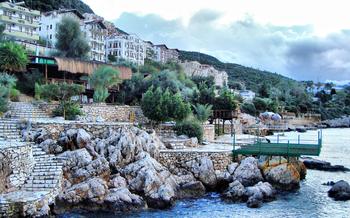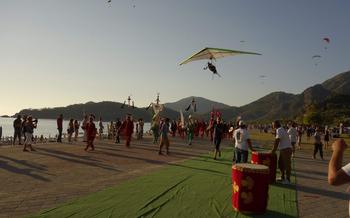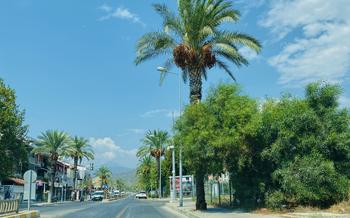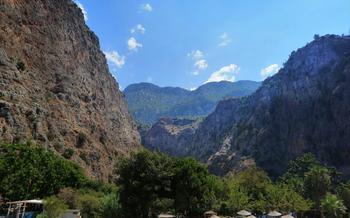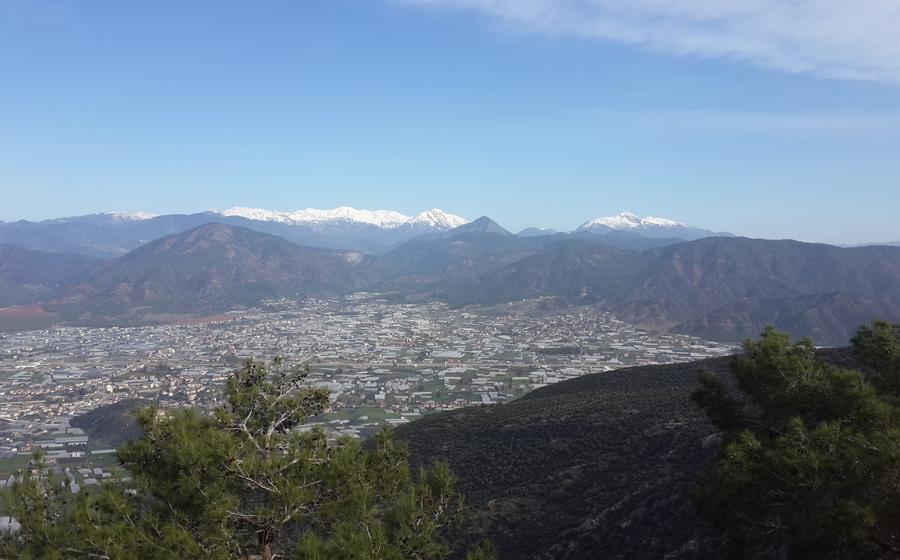
Letoon Ancient City
- Historical Significance
- Location and Accessibility
- Archaeological Excavations at Letoon
- Temple of Leto
- Other Temples and Structures
- Theater and Odeon
- City Walls and Gates
- Necropolis and Tombs
- Inscriptions and Reliefs
- Museum of Fethiye
- Nearby Attractions
- Accommodation and Dining
- Local Culture and Traditions
- Best Time to Visit
- Insider Tip
Historical Significance
Letoon, an ancient city of great significance, was founded in the 7th century BC by the Lycians, an Anatolian civilization known for their maritime prowess and cultural achievements. The city's strategic location on the trade route between Anatolia and the Mediterranean made it a thriving commercial center. Its importance was further enhanced by its religious significance as a sanctuary dedicated to the goddess Leto, mother of Apollo and Artemis. The city's sacred precinct housed several temples, including the Temple of Leto, which attracted pilgrims from across the Lycian League. Letoon's rich history and cultural heritage make it a fascinating destination for travelers interested in ancient civilizations and archaeology.
Location and Accessibility
Letoon Ancient City is situated in the Fethiye region of Turkey, approximately 4 kilometers south of the modern city of Fethiye. It is easily accessible by public transport or car, with regular buses departing from Fethiye's central bus station. For those traveling by car, the ancient city is well-signposted and can be reached via the D400 highway.
Letoon's proximity to other popular tourist attractions in the region makes it an ideal destination for a day trip or as part of a longer itinerary. Visitors can conveniently combine their visit to Letoon with a trip to the stunning Patara Beach, located just 15 kilometers to the south.
The ancient city is open to visitors daily, with entrance fees set at a reasonable rate. Visiting hours vary depending on the season, but generally range from 8:00 AM to 5:00 PM. Travelers are advised to check the official website or local tourist information centers for the most up-to-date information on entrance fees and visiting hours.
Archaeological Excavations at Letoon
Letoon has been the subject of ongoing archaeological excavations for over a century, with significant discoveries shedding light on the city's rich history and cultural significance. International teams of archaeologists have been involved in these excavations, working to uncover the secrets of this ancient city.
The excavations have revealed impressive structures, including temples, theaters, and other public buildings, providing valuable insights into the city's urban planning and architectural achievements. Among the most notable discoveries are the remains of a large temple dedicated to the goddess Leto, as well as a well-preserved theater and odeon, suggesting the city's vibrant cultural and religious life.
The ongoing excavations continue to uncover new artifacts and structures, contributing to our understanding of Letoon's role as a religious center and a stop on the ancient trade route between Anatolia and the Mediterranean. The future plans for the site include the preservation and restoration of the excavated structures, ensuring their protection for future generations.
Temple of Leto
The Temple of Leto, the most prominent structure in Letoon, is an architectural masterpiece that reflects the Lycians' exceptional craftsmanship and devotion to their deities. Built in the 4th century BC, the temple features a classic Greek design with a rectangular plan and a peristyle of Ionic columns. Its impressive façade boasts elaborate pediments adorned with intricate sculptures depicting scenes from mythology. The interior of the temple was once home to a colossal statue of the goddess Leto, which unfortunately has not survived to this day. Despite its age, the Temple of Leto remains remarkably well-preserved, showcasing the enduring legacy of the Lycian civilization.
Archaeological excavations have revealed a treasure trove of artifacts within the temple, shedding light on the religious practices and beliefs of the ancient Lycians. Among the most notable discoveries are inscriptions and reliefs that provide valuable insights into the mythology and rituals associated with Leto and her children, Apollo and Artemis. These artifacts have played a crucial role in reconstructing the history and significance of Letoon as a sacred center of worship.
Theories abound regarding the construction and use of the Temple of Leto over time. Some scholars believe that the temple underwent several phases of construction and modification, reflecting the changing political and religious landscape of the region. Others suggest that the temple served not only as a place of worship but also as a political and administrative center, housing important civic functions. Regardless of its exact purpose, the Temple of Leto stands as a testament to the Lycians' architectural prowess and their deep reverence for their gods.
Other Temples and Structures
Apart from the Temple of Leto, Letoon boasts several other significant structures that reflect the religious and civic life of the ancient city. The Temple of Artemis, dedicated to the goddess of hunting and nature, stands out with its well-preserved foundations and fragments of columns. The Temple of Apollo, honoring the god of music and prophecy, features an impressive facade and intricate carvings depicting mythological scenes. The Bouleuterion, or council house, served as a meeting place for the city's administrators and elders, showcasing the political significance of Letoon.
The Prytaneion, the public dining hall, features a large courtyard surrounded by rooms used for official banquets and religious ceremonies. The Gymnasium, dedicated to physical education, comprised a palestra for wrestling and a large open space for other athletic activities. These structures, along with smaller temples and altars dedicated to various deities, provide a glimpse into the diverse religious beliefs and practices of the ancient Lycians.
Theater and Odeon
The theater and odeon in Letoon are impressive structures that showcase the city's cultural and civic significance. The theater, with its well-preserved seating rows, stage, and orchestra pit, could accommodate up to 2,500 spectators. It was used for theatrical performances, musical concerts, and other public events. The acoustics of the theater are remarkable, ensuring that even the faintest whispers could be heard from the back rows.
The odeon, a smaller structure adjacent to the theater, served as a venue for more intimate performances and gatherings. Similar to the theater, the odeon features a stage, seating rows, and excellent acoustics. These performance venues played a vital role in the cultural life of Letoon, providing a platform for artistic expression and community events. Ongoing efforts are underway to restore and preserve these structures, ensuring that future generations can continue to appreciate their architectural beauty and historical significance.
City Walls and Gates
The city walls of Letoon, constructed in the 4th century BCE, once encircled the entire city, providing protection from potential threats. These impressive fortifications featured sturdy stone construction and multiple gates that allowed controlled access to the city. While time and natural elements have eroded portions of the walls, visitors can still admire their grandeur and strategic placement. The main gate, located on the city's west side, served as the primary entrance and exit point for trade and travel. Its imposing structure, adorned with intricate carvings, hints at the significance of Letoon as a bustling center of commerce and culture. Ongoing efforts are underway to study and preserve these defensive structures, ensuring that future generations can appreciate their historical significance and architectural prowess.
Necropolis and Tombs
In the vicinity of the Letoon Ancient City, a vast necropolis, or cemetery, awaits exploration. This sprawling burial ground offers a glimpse into the funerary practices and beliefs of the ancient Lycians. Various types of tombs can be found here, ranging from simple rock-cut graves to elaborate monumental structures.
One notable feature of the Letoon necropolis is the presence of rock-cut tombs with intricate facades and inscriptions. These tombs often feature elaborate carvings depicting scenes from mythology, daily life, or religious ceremonies. The inscriptions, often written in the Lycian language, provide valuable insights into the names, lineages, and social status of the deceased.
Another type of tomb found in the necropolis is the chamber tomb. These tombs consist of a central chamber with multiple niches or alcoves for burials. The walls of the chambers are often adorned with frescoes or paintings depicting scenes from the afterlife or funerary rituals.
The discovery of artifacts within the tombs has shed light on the burial customs of the Lycians. Grave goods such as pottery, jewelry, weapons, and personal items were often placed alongside the deceased to accompany them on their journey to the afterlife.
Ongoing efforts are underway to study and preserve the tombs and artifacts of the Letoon necropolis. Archaeological excavations continue to uncover new tombs and provide valuable information about the Lycian culture and their beliefs surrounding death and the afterlife.
Inscriptions and Reliefs
Letoon is a treasure trove of inscriptions and reliefs that provide valuable insights into the history, culture, and beliefs of the ancient Lycians. These inscriptions are mostly written in the Lycian language, which is still being deciphered by scholars. They record important events, religious rituals, and the names of prominent individuals. The reliefs, on the other hand, depict scenes from mythology, daily life, and religious ceremonies.
One of the most notable inscriptions found at Letoon is the Bilingual Inscription, which is written in both Lycian and Greek. This inscription provides a key to understanding the Lycian language and has helped scholars to decipher other Lycian inscriptions. Other significant inscriptions include the Stele of Leto, which records the foundation of the city, and the Stele of the Lycian League, which documents the formation of a political alliance among Lycian cities.
The reliefs at Letoon are equally impressive. They depict a variety of subjects, including gods and goddesses, mythological creatures, and scenes from daily life. One of the most striking reliefs is the Lion Hunt Relief, which shows a group of hunters on horseback pursuing a lion. Another notable relief is the Birth of Leto's Children, which depicts the goddess Leto giving birth to Apollo and Artemis.
The inscriptions and reliefs of Letoon are not only beautiful works of art, but also important historical documents. They provide a glimpse into the lives and beliefs of the ancient Lycians and help us to understand their rich and complex culture.
Museum of Fethiye
To delve deeper into the history and significance of Letoon, a visit to the Fethiye Museum is highly recommended. This museum houses an impressive collection of artifacts unearthed from the ancient city, providing a tangible connection to its past. Among the highlights are sculptures that once adorned the temples, pottery that offers insights into daily life, and inscriptions that shed light on the culture and beliefs of the Lycians. The museum's well-curated exhibits allow visitors to appreciate the artistry and craftsmanship of this ancient civilization. Special exhibitions or events related to Letoon are often held at the museum, offering a unique opportunity to learn more about the ongoing research and discoveries at the site.
Nearby Attractions
Letoon's proximity to other captivating attractions in the Fethiye region makes it an ideal base for exploring the area's rich cultural and natural heritage. Ölüdeniz Beach, renowned for its breathtaking turquoise waters and white sandy shores, is a must-see destination. Visitors can bask in the sun, swim in the crystal-clear sea, or indulge in thrilling water sports like paragliding or scuba diving.
The Saklıkent Gorge, another natural wonder, offers a unique adventure. This narrow canyon, with towering rock walls and a refreshing river running through it, can be explored on foot or by taking a refreshing dip in its cool waters. The Fethiye Castle, a magnificent historical landmark, stands proudly atop a hill overlooking the city. Its well-preserved fortifications, panoramic views, and intriguing history make it a popular attraction for history buffs and nature enthusiasts alike.
These attractions, all within easy reach of Letoon, can be easily combined to create a diverse and memorable itinerary. Visitors can spend a day exploring the ancient city, followed by a relaxing afternoon at Ölüdeniz Beach, and end the day with a breathtaking sunset from the Fethiye Castle. Alternatively, they can embark on a thrilling canyoning adventure at the Saklıkent Gorge, followed by a visit to Letoon's ruins to delve into the region's rich past.
Accommodation and Dining
When planning your visit to Letoon, consider staying in Fethiye or the nearby villages to immerse yourself in the local culture and enjoy a range of accommodation options. Fethiye offers a variety of hotels, hostels, and guesthouses to suit different budgets and preferences. For a luxurious stay, consider the five-star Yacht Classic Hotel or the Hillside Beach Club, which offers stunning views of the Mediterranean Sea. Budget travelers can opt for cozy guesthouses like the Pasa Pansiyon or the Ece Pension, which offer comfortable rooms at affordable prices.
In terms of dining, Fethiye's culinary scene is diverse and caters to various tastes. Indulge in traditional Turkish cuisine at local restaurants, where you can savor mouthwatering dishes like kebabs, mezes, and freshly caught seafood. For a taste of international flavors, head to the many restaurants along the harbor, which offer everything from Italian pasta to Indian curries. Don't miss the opportunity to try local delicacies like gözleme (stuffed flatbread), pişi (fried dough), and the famous Turkish delight, a sweet treat made from sugar, starch, and nuts.
To cater to dietary restrictions, many restaurants in Fethiye offer vegetarian and vegan options. Be sure to inform the staff about any allergies or special requests to ensure a safe and enjoyable dining experience.
Local Culture and Traditions
The Fethiye region is rich in local culture and traditions that reflect the diverse heritage of the area. Visitors to Letoon may encounter traditional Turkish festivals and events, such as wrestling competitions, folk dancing performances, and colorful celebrations. It is important to be respectful of local customs and traditions, such as dressing modestly and observing religious practices. To immerse oneself in the local culture, visitors can try traditional Turkish cuisine, attend a Turkish bath, or learn a few basic Turkish phrases. Engaging with the local people and experiencing their way of life can create a deeper connection with the region and its history.
Best Time to Visit
The best time to visit Letoon and the Fethiye region is during the shoulder seasons, which fall between April-May and September-October. During these months, the weather is generally mild and pleasant, with warm and sunny days and cool nights. The crowds are also smaller compared to the peak summer season, making it easier to explore the ancient city and other attractions without feeling overwhelmed.
Visiting Letoon during the summer months (June-August) can be quite hot and humid, with temperatures often reaching into the 30s Celsius. However, this can also be a good time to visit if you enjoy swimming and other water-based activities, as the Mediterranean Sea is at its warmest during this time.
The winter months (November-March) can be quite chilly and wet, with occasional snowfall in the higher elevations. While this may not be the ideal time for exploring the ancient city, it can be a good time to visit if you are looking for a more peaceful and solitary experience.
If you are interested in attending specific events or festivals, it is worth checking the local calendar before planning your trip. The Fethiye region hosts various cultural and sporting events throughout the year, including the Fethiye Food Festival in May, the Fethiye Yacht Festival in June, and the Ölüdeniz Air Games in October.
Insider Tip
Letoon is an ancient city brimming with historical significance and archaeological wonders. As you wander through its ruins, let your imagination transport you back to a time when gods and goddesses roamed the earth. Don't miss the opportunity to explore the hidden corners of the site, where you may stumble upon lesser-known structures or serene spots to soak in the tranquility of the ancient world. And if you're feeling adventurous, venture beyond the city walls to discover the picturesque villages nestled amidst the surrounding mountains, where you can experience the warmth and hospitality of the Turkish people and savor the delights of traditional cuisine.
